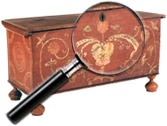Stereograph & Stereoviews
A stereograph or stereoview is a pair of almost identical images mounted side by side on a pasteboard card. The mounted images are then placed in a stereoscope. When viewed the images merge to form one three-dimensional image.
Some of the key names in early stereo photography in the U.S. working in the 1850′s and 1860′s were E. & H. T. Anthony, George Baker, Charles Bierstadt, Matthew Brady, C. D. Fredericks, Jeremiah Gurney, Kilburn Brothers, Edward Muybridge, G. W. Pach, Charles Savage, John Soule, Thomas Houseworth and Carleton Watkins. The list of active stereo photographers during this period would likely number in the thousands.
Later developments saw the growth of larger companies such as the Keystone View Company, Realistic Travels and Underwood & Underwood. These companies mass produced both individual views and boxed sets of views. These boxed series vary in both size and rarity. They include topographical sets, humorous series, and major events such as the Civil War, international exhibitions and later WWI. The First World War set became one of the most commonly produced and, along with the “Tour of the World” series, is still widely available today. From 1900 Underwood & Underwood and Keystone sold individual views and boxed sets door-to-door. Some of their best selling series also include a brief book with accompanying descriptions. Today these sets can range in price from under $100 to several thousands of dollars.
As in the U.S., many stereo photographers were active in both England and Europe in the 1850′s and 1860′s. Some of the key names here were Francis Bedford, Valentine Blanchard, Adolph Braun, P. H. Delamotte, James Elliott, William England, Roger Fenton, Ferrier & Soulier, Francis Frith, Frank M. Good, Leon & Levy, London Stereoscopic Company, Negretti & Zambra, T. R. Williams and G. W. Wilson.
There is a vast array of individual views and sets of views available to the collector. Because of this it would be difficult to cover all possible areas of interest. The market value is based on subject matter, photographer and condition. In some cases a rare view in poor condition will still command a higher price, but condition is a key factor in pricing.
Some of the earlier stereo formats such as stereo daguerreotypes, stereo ambrotypes and glass stereoviews are highly sought by collectors. These formats command significantly higher prices ranging from a few hundred to many thousands of dollars. When collecting boxed sets, a complete set will command a higher price. Sets with missing views are significantly discounted. Sets that have their original boxes and literature will command a higher price. Prices for individual views can vary greatly in price from as little as a dollar to many thousands for an exceptionally rare view in great condition. One significant category that is worthy of mention is tissue, or hold-to-light views, that are also keenly collected. These photographs are printed on thin tissue paper that has been back tinted. When held to the light these views reveal a beautifully colored image.
The basic stereo card measures approximately 3.25 inches by 7 inches varying slightly depending upon manufacturer. As a general rule the earlier views were mounted on thinner card stock with square corners. The card itself was initially flat but later improvements led to heavier and slightly curved card stock. This was meant to give a better three-dimensional effect, although in actuality, it does not enhance the illusion.
The stereoview reigned supreme from the mid-1850′s until the early 1930′s, with almost every major event covered. In the late 1930′s the last mass market development of three dimensional images was born in the form of TRU-VUE and ViewMaster, with the latter being the dominant brand. These reels are highly collectible, and are an excellent way for beginning collectors on a modest budget to obtain examples of stereo photography.
Reference note by p4A Contributing Editor Robert M. Ginns.
